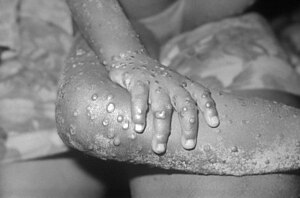The cause of Monkeypox
Monkeypox is an infectious disease caused by the monkeypox virus. Symptoms begin with fever, headache, muscle pains, swollen lymph nodes, and feeling tired. This is than followed by a rash that forms blisters and scabs over.The time from exposure to onset of symptoms is around 10 days. The duration of symptoms is typically 2 to 4 weeks.
Monkeypox may be spread from handling bush meat, an animal bite or scratch, body fluids, contaminated objects, or close contact with an infected person.The virus is believed to normally circulate among certain rodents in Africa. Diagnosis can be confirmed by testing a lesion for the viruses DNA. The disease can appear similar to chickenpox.
The smallpox vaccine is believed to prevent infection. Cidofovir may be useful as treatment.The risk of death in those infected is up to 10%.
The disease mostly occurs in Central and West Africa. It was first identified in 1958 among laboratory monkey. The first cases in humans were found in 1970 in the Democratic Republic of the Congo.
Monkeypox virus
Monkeypox virus causes the disease in both humans and animals. It was first identified in 1958 as a pathogen of crab-eating macaquemonkeys (Macaca fascicularis) being used as laboratory animals. The crab-eating macaque is often used for neurological experiments. Monkeypox virus is an Orthopoxvirus, a genus of the family Poxviridae that contains other viral species that target mammals. The virus is found mainly in tropical rainforest regions of central and West Africa.
The virus was first discovered in monkeys (hence the name) in 1958, and in humans in 1970. Between 1970 and 1986, over 400 cases in humans were reported. Small viral outbreaks with a death rate in the range of 10% and a secondary human to human infection rate of about the same amount occur routinely in equatorial Central and West Africa. The primary route of infection is thought to be contact with the infected animals or their bodily fluids.The first reported outbreak in the United States occurred in 2003 in the midwestern states of Illinois, Indiana, and Wisconsin, with one occurrence in New Jersey. The outbreak was traced to a prairie dogs infected from an imported Gambian pouch rat. No deaths occurred.
The virus can spread both from animal to human and from human to human. Infection from animal to human can occur via an animal bite or by direct contact with an infected animal’s bodily fluids. The virus can spread from human to human by both respiratory (airborne) contact and contact with infected person's bodily fluids. Risk factors for transmission include sharing a bed, room, or using the same utensils as an infected patient. Increased transmission risk associated with factors involving introduction of virus to the oral mucosa. Incubation period is 10–14 days. Prodromal symptoms include swelling of lymph nodes, muscle pain, headache, fever, prior to the emergence of the rash.The rash is usually only present on the trunk but has the capacity to spread to the palms and soles of the feet, occurring in a centrifugal distribution. The initial macular lesions exhibit a papular, then vesicular and pustular appearance.


Comments